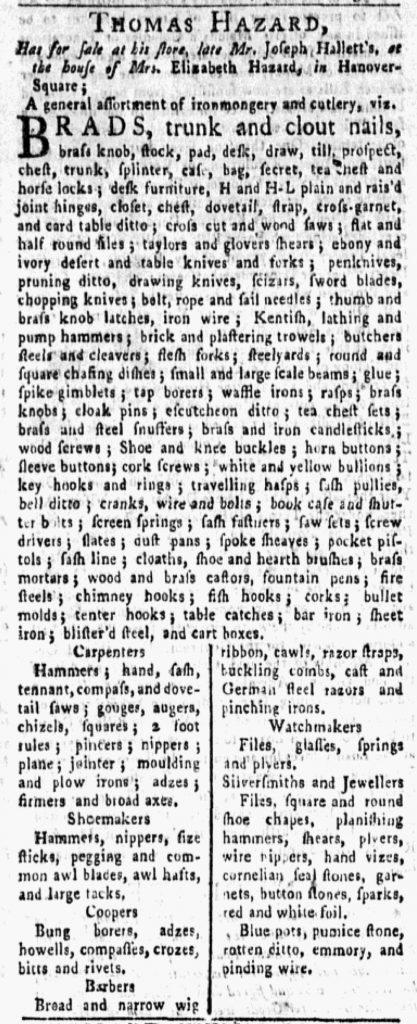What was advertised in a colonial American newspaper 250 years ago this week?

“Coopers Bung borers, adzes, howells, compasses, crozes, bitts and rivets.”
In the 1770s, when merchants and shopkeepers enumerated the “general assortment” of goods they offered for sale, their advertisements usually followed one of two formats. Most listed their merchandise in a dense paragraph of text that extended anywhere from a few lines to half a column or more. As an alternative, others created more white space and made their advertisements easier to read by including only one item per line or organizing their wares into columns. Adopting such methods meant that advertisers could name fewer items in the same amount of space as their competitors who chose paragraphs of text with no white space.
Both sorts of advertisements regularly appeared in the New-York Gazette and Weekly Mercury, but occasionally advertisers (perhaps in consultation with printers and compositors) added variations and innovations. Such was the case with Thomas Hazard’s advertisement for ironmongery and cutlery in the August 13, 1770, edition. Hazard began with a dense paragraph that included “H and H-L plain and rais’d joint hinges,” “brass and iron candlesticks,” and “sword blades.” In addition, he divided a portion of his advertisement into two columns. Within those columns, he resorted to short paragraphs of text rather than listing only one or two items per line, but those paragraphs were brief and likely easier for eighteenth-century consumers to navigate than the dense paragraph of text that constituted the bulk of the advertisement. Furthermore, Hazard inserted headers for each of those shorter paragraphs: “Carpenters,” “Shoemakers,” “Coopers,” “Barbers,” “Watchmakers,” and “Silversmiths and Jewellers.” Each paragraph listed tools used in a particular trade. In this manner, Hazard targeted specific consumers and aided artisans in finding the items of greatest interest to them.
Prior to the American Revolution, merchants and shopkeepers published undifferentiated lists of goods in their advertisements, but occasionally some attempted to impose more order and make their notices easier for prospective customers to navigate. Thomas Hazard did so by grouping together tools used by various sorts of artisans, setting them apart in columns, and using headers to draw attention to them. Carpenters or watchmakers who might have overlooked items when skimming dense paragraphs of text instead had a beacon that called their attention to the tolls of their trades.
